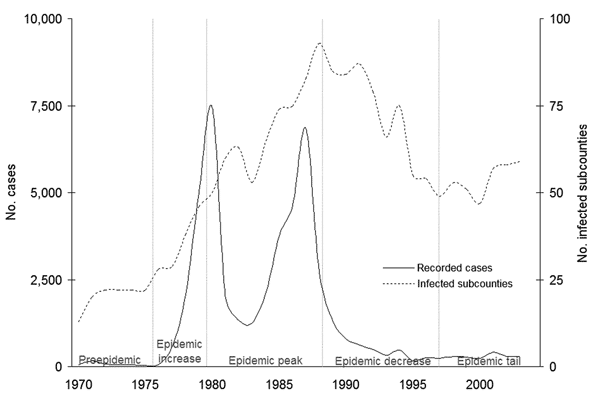Volume 12, Number 5—May 2006
Historical Review
Spatial Analysis of Sleeping Sickness, Southeastern Uganda, 1970–2003
Figure 3

Figure 3. Number of sleeping sickness cases and infected subcounties, southeastern Uganda, 1970–2003. Number of recorded cases refer to totals for southeastern Uganda. Sources: 1970–1971, D.B. Mbulamberi, unpub. data; 1972–1975 (18); and 1976–2001 (Ministry of Health, 2004).
References
- Jordan AM. Trypanosomiasis control and land use in Africa. Outlook Agric. 1979;10:123–9.
- Jordan AM. Trypanosomiasis control and African rural development. Harlow (UK): Longman; 1986.
- Leak SG. Tsetse biology and ecology: their role in the epidemiology and control of trypanosomosis. Wallingford (UK): CABI Publishing in association with the International Livestock Research Institute, Nairobi, Kenya; 1999.
- Fèvre EM, Coleman PG, Welburn SC, Maudlin I. Reanalyzing the 1900–1920 sleeping sickness epidemic in Uganda. Emerg Infect Dis. 2004;10:567–73.PubMedGoogle Scholar
- Welburn SC, Fèvre EM, Coleman PG, Odiit M, Maudlin I. Sleeping sickness: a tale of two diseases. Trends Parasitol. 2001;17:19–24. DOIPubMedGoogle Scholar
- Koerner T, de Raadt P, Maudlin I. The Uganda sleeping sickness epidemic revisited: a case of mistaken identity? Parasitol Today. 1995;11:303–6. DOIPubMedGoogle Scholar
- Fèvre EM, Coleman PG, Odiit M, Magona JW, Welburn SC, Woolhouse ME. The origins of a new Trypanosoma brucei rhodesiense sleeping sickness outbreak in eastern Uganda. Lancet. 2001;358:625–8. DOIPubMedGoogle Scholar
- Matovu FS. Rhodesian sleeping sickness in south-eastern Uganda (the present problems). East Afr Med J. 1982;59:390–3.PubMedGoogle Scholar
- Ministry of Health. Uganda sleeping sickness records. Kampala, Uganda: the Ministry; 2004.
- Rodriguez A. Trypanosomiasis—Uganda (Kaberamaido). [cited 2005 Jan 27]. Available from http://www.promedmail.org
- Uganda Bureau of Statistics. Uganda population and housing census, years: 1980, 1991, 2002. Kampala: Government of Uganda.
- Leggett I. Uganda. Oxford (UK): Fountain Publishers Ltd.; 2001.
- Jamal V. The agrarian context of the Ugandan crisis. In: Hansen HB, Twaddle M, editors. Changing Uganda: the dilemmas of structural adjustment and revolutionary change. Kampala, Uganda: Fountain Publishers; 2001. p. 78–97.
- Kulldorff M, Athas W, Feuer E, Miller B, Key C. Evaluating cluster alarms: a space-time scan statistic and brain cancer in Los Alamos. Am J Public Health. 1998;88:1377–80. DOIPubMedGoogle Scholar
- Waller LA, Gotway CA. Applied spatial statistics for public health data. New York: John Wiley & Sons; 2004.
- Moore DA. Spatial diffusion of raccoon rabies in Pennsylvania, USA. Prev Vet Med. 1999;40:19–32. DOIPubMedGoogle Scholar
- Berke O. Estimation and prediction in the spatial linear model. Water Air Soil Pollut. 1999;110:215–37. DOIGoogle Scholar
- Okiria R. The prevalence of human trypanosomiasis in Uganda, 1970 to 1983. East Afr Med J. 1985;62:813–6.PubMedGoogle Scholar
- Abaru DE. Sleeping sickness in Busoga, Uganda, 1976–1983. Trop Med Parasitol. 1985;36:72–6.PubMedGoogle Scholar
- Odiit M, Coleman PG, McDermott JJ, Fèvre EM, Welburn SC, Woolhouse ME. Spatial and temporal risk factors for the early detection of Trypanosoma brucei rhodesiense sleeping sickness patients in Tororo and Busia districts, Uganda. Trans R Soc Trop Med Hyg. 2004;98:569–76. DOIPubMedGoogle Scholar
- Odiit M, Shaw A, Welburn SC, Fèvre EM, Coleman PG, McDermott JJ. Assessing the patterns of health-seeking behaviour and awareness among sleeping-sickness patients in eastern Uganda. Ann Trop Med Parasitol. 2004;98:339–48. DOIPubMedGoogle Scholar
- Odiit M, Coleman PG, Liu WC, McDermott JJ, Fevre EM, Welburn SC, Quantifying the level of under-detection of Trypanosoma brucei rhodesiense sleeping sickness cases. Trop Med Int Health. 2005;10:840–9. DOIPubMedGoogle Scholar
- Mbulamberi DB. Possible causes leading to an epidemic outbreak of sleeping sickness: facts and hypotheses. Ann Soc Belg Med Trop. 1989;69(Suppl 1):173–9.PubMedGoogle Scholar
- Welburn SC, Odiit M. Recent developments in human African trypanosomiasis. Curr Opin Infect Dis. 2002;15:477–84. DOIPubMedGoogle Scholar
Page created: January 12, 2012
Page updated: January 12, 2012
Page reviewed: January 12, 2012
The conclusions, findings, and opinions expressed by authors contributing to this journal do not necessarily reflect the official position of the U.S. Department of Health and Human Services, the Public Health Service, the Centers for Disease Control and Prevention, or the authors' affiliated institutions. Use of trade names is for identification only and does not imply endorsement by any of the groups named above.